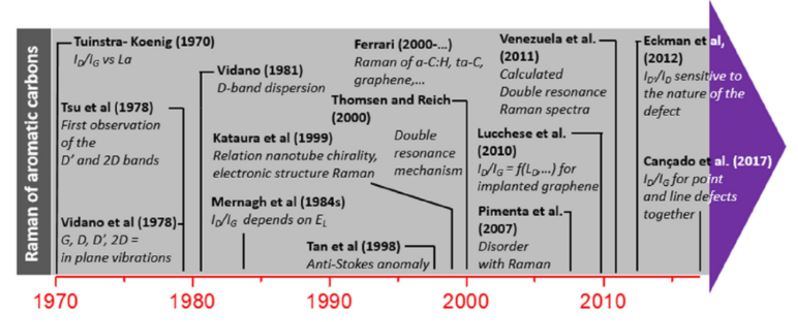Video Article Open Access
Advanced Raman Microscopy used to Characterize Amorphous Carbons and Modified Graphene Layers
Cedric Pardanaud1,*, Alexandre Merlen2, Josephus Gerardus Buijnsters3, Dmytro Nikolaievskyi1,4, Sylvain Clair2, Olivier Chuzel4, Gilles Cartry1, Pascale Roubin1
1Aix Marseille Univ, CNRS, PIIM, Marseille, France
2Aix Marseille Univ, Université de Toulon, CNRS, IM2NP, Marseille, France
3Dept. of Precision and Microsystems Engineering, Research Group of Micro and Nano Engineering, Delft University of Technology, Delft, The Netherlands
4Aix Marseille Univ, CNRS, Centrale Marseille, iSm2, Marseille, France
Vid. Proc. Adv. Mater., Volume 3, Article ID 2206204 (2022)
DOI: 10.5185/vpoam.2022.06204
Publication Date (Web): 24 Sep 2022
Copyright © IAAM
Graphical Abstract

Abstract
Sp2 hybridized carbons constitute a broad class of solid phases composed primarily of elemental carbon and can be either synthetic or naturally occurring. Some examples are graphite, chars, soot, graphene, carbon nanotubes, pyrolytic carbon, and diamond-like carbon. They vary from highly ordered to completely disordered solids and detailed knowledge of their internal structure and composition is of utmost importance for the scientific and engineering communities working with these materials. Multiwavelength Raman spectroscopy has proven to be a very powerful and non-destructive tool for the characterization of carbons containing both aromatic domains and defects. Depending on the material studied, some specific spectroscopic parameters (e.g., band position, full width at half maximum, relative intensity ratio between two bands) are used to characterize defects. We review the way Raman spectroscopy is used for studying sp2 based carbon samples containing defects, with a special focus on a-C:H layers, with post heat treatment up to 800°C. Counterintuitively, because of the electronic structure of aromatic building blocks, Raman spectra are driven by electronic properties: Phonons and electrons being coupled by the double resonance mechanism. This justifies the use of multiwavelength Raman spectroscopy to better characterize these materials. We conclude with the possible influence of both phonon confinement and curvature of aromatic planes on the shape of a-C:H and defective carbons Raman spectra. We also report on the formation of weakly interacting Multi-layer graphene by using nanomechanical folding induced by an AFM tip on CVD-transferred graphene. More precisely, vertical forces in the μN range were applied on 4 μm square zones that induced a cut and push process leading to the formation of these weakly interacting Multi-layer graphene. We highlight what kind of information can be obtained by advanced Raman microscopy.
Keywords
Raman microscopy; amorphous carbon; defective graphite; modified graphene.
References
- A. Merlen, J. G. Buijnsters and C. Pardanaud, Coatings, 2017, 7, 153.
- A. Merlen, J. G. Buijnsters and C. Pardanaud All-carbon composites and hybrids, chapter 13, Edited by Boris Kharisov, Royal Society of Chemistry, 2021.
- C. Pardanaud, et al. C-journal of Carbon Research, 2019, 5, 79.
- C. Pardanaud, et al. Diamond and Related Materials, 2013, 34, 100-104.
- C. Pardanaud, A. Merlen et al. The Journal of Physical Chemistry Letters, 2019, 10, 3571.
Biography
Cedric Pardanaud has obtained his PhD in experimental molecular physics, working on nuclear spin conversion of water molecules embedded in cryogenic matrix, measured by infrared spectroscopy and with astrophysical interest. In 2007 he started working in the group of Pascale Roubin, developing the use of Raman microscopy applied to materials science. More precisely he was involved in plasma/wall interaction occurring in tokamaks. He started investigating, among others, amorphous carbons and defective graphite, employing a methodology based on the comparison of samples collected in tokamaks and synthetized in labs. More recently he started to study a cut and fold method to obtain graphene multilayer from single layer graphene.
Video Proceedings of Advanced Materials

Upcoming Congress



